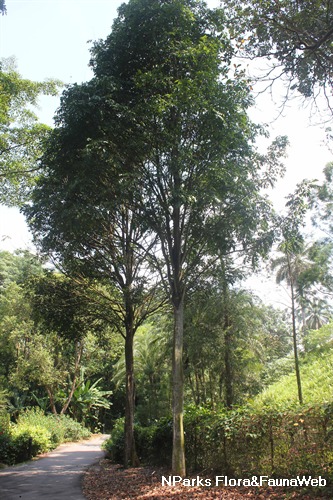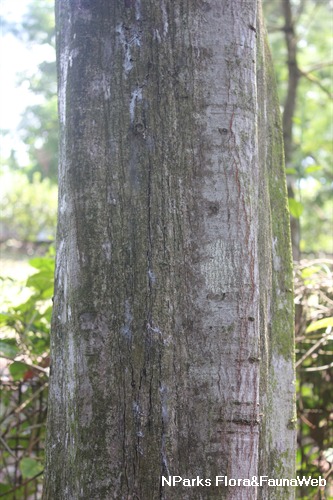
Back
Dacryodes rostrata (Blume) H.J.Lam
| Family Name: | Burseraceae |
| Synonyms: | Canarium caudatifolium, Canarium crassifolium, Canarium cuspidatum, Canarium gilvescens, Canarium kadondon, Canarium minahassae, Canarium montanum, Canarium reticulatum, Canarium rostriferum, Santiria rostrata |
| Common Name: | Kedondong Kerut, Kembayau |
Name
Classifications and Characteristics
| Plant Division | Angiosperms (Flowering Seed Plants) |
|---|---|
| Plant Growth Form | Tree |
| Lifespan (in Singapore) | Perennial |
| Mode of Nutrition | Autotrophic |
Biogeography
| Native Distribution | Indochina, Thailand, Peninsular Malaysia, Philippines, Sumatera, Sulawesi, Borneo |
|---|---|
| Native Habitat | Terrestrial (Primary Rainforest, Secondary Rainforest) |
| Preferred Climate Zone | Tropical |
| Local Conservation Status | Native to Singapore (Vulnerable (VU)) |
Description and Ethnobotany
| Growth Form | It is an evergreen tree up to 40 m tall with 1 m of trunk diameter and low buttresses. |
|---|---|
| Foliage | Leaves are alternate, pinnate, 2-10 jugate; leaflets ovate-oblong, papery with asymmetrical base, leaf apex elongated and widening at the tip; leaf rachis is swollen at junction with leaf stalk and hairy,petiole with or without resinous ducts. |
| Flowers | Panicles are axillary, often combined into a terminal inflorescence. Flowers three to numerous, small, 3 mm across, yellowish-white, calyx copular and shortly dentate. Male flowers have six stamens, connate to periphery of disk; female flowers have six staminodes, three-loculed ovary with sessile three-lobed stigma. |
| Fruit | Fruit is ovoid to oblong, fleshy drupe, 2-4 cm x 1-2 cm, yellow-brown unripe to purplish-black when ripens, containing one hard seed in the centre. |
| Ethnobotanical Uses | Edible Plant Parts : Edible Fruits, Edible Seeds Food (Fruit or Vegetable): Fruit pulp is preserved in salt and fried as an appetizer with rice or porridge. Its fleshy seed cotyledons are also edible. Timber & Products: The wood is used for planks Others: The resin obtained from the tree is said to be used for making torches. |
Fauna, Pollination and Dispersal
| Seed or Spore Dispersal | Biotic (Fauna) |
|---|
Plant Care and Propagation
| Light Preference | Full Sun |
|---|---|
| Water Preference | Moderate Water |
| Plant Growth Rate | Moderate |
| Rootzone Tolerance | Moist Soils |
Foliar
| Foliage Retention | Evergreen |
|---|---|
| Foliar Arrangement Along Stem | Alternate |
| Foliar Attachment to Stem | Petiolate |
| Foliar Shape(s) | Non-Palm Foliage (Ovate, Oblong) |
Non - Foliar and Storage
| Trunk Type (Non Palm) | Woody |
|---|
Floral (Angiosperm)
| Flower Colour(s) | White |
|---|---|
| Flower Grouping | Cluster / Inflorescence |
| Flower Location | Terminal, Axillary |
| Inflorescence Type | Panicle |
| Flower Colour(s) Remarks | yellowish-white |
Fruit, Seed and Spore
| Mature Fruit Colour(s) | Black |
|---|---|
| Fruit Classification | Simple Fruit |
| Fruit Type | Fleshy Fruit |
Image Repository
Others
| Master ID | 29590 |
|---|---|
| Species ID | 3899 |
| Flora Disclaimer | The information in this website has been compiled from reliable sources, such as reference works on medicinal plants. It is not a substitute for medical advice or treatment and NParks does not purport to provide any medical advice. Readers should always consult his/her physician before using or consuming a plant for medicinal purposes. |

